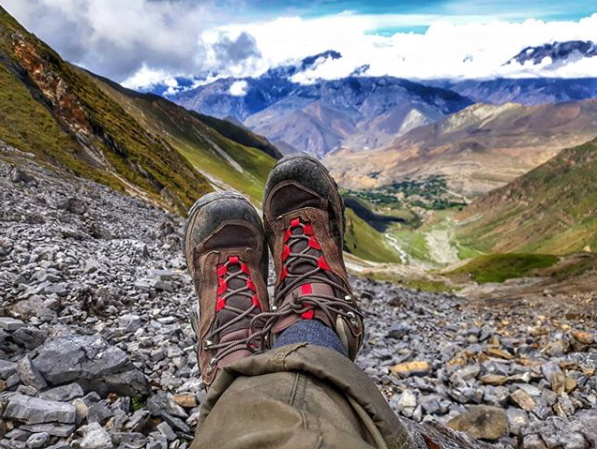
If I had a dime for every time someone asked me how do I travel with a full-time job, I’d be a millionaire right now! Okay, I’m exaggerating! But yes, every time people find out I travel with a full-time job, I see a question mark forming in their faces.
The answer is quite simple, really.
It’s all about — here comes the magic word — PRIORITIES.
I find time to travel because I WANT to travel.
I travel anywhere between 1-2 months a year with a full-time job. I’ve traveled to over 15 states in India, and 12 countries — all with a full-time job.
While I always used to look forward to yearly family trips, I only realized how gratifying travel can be just about 4 years ago. It was on my first Himalayan trek in Uttarakhand (Kuari Pass) that changed the way I travel. And since then there’s no looking back. I’ve traveled far and wide, nationally, and internationally and my love for travel has only gotten stronger.
The thing with priorities, however, is that it keeps changing. Something which is a priority to you, probably won’t be so in a year, or even tomorrow. Understand what your priorities are, and work towards it.
Look at your holiday calendar and plan your vacation ahead
Traveling with a full-time job requires far more planning than otherwise required. The first advice I’d give to all travel enthusiasts with a full-time job is to plan your vacation ahead. There’s only limited holidays and leaves available in a year, so it bodes well to plan for long trips well in advance.
Look for long weekends, holidays, lesser workload season to plan for multi-week trips. This will provide you enough time to intimate your team as well as set up funds for travel, and save money from impulsive travel.
I’m an impulsive planner and most of the long term travels have been planned within a month or lesser. But I would definitely suggest planning ahead which will help in saving time, money, and lot of last minute problems.
Join a company with good work culture and flexible leave policy
It’s important to set your expectations right when you join a company. If you are working day and night with little upside, then maybe it’s time to move on.
Most of my travel plans worked out because I carefully chose what kind of companies I want to work in. I’ve had the opportunity to work at Akamai, and currently Expedia, both very good companies when it comes to work culture.
However, don’t mistake it for slacking either. If you optimize your time during work hours, you can finish work right on time. That means shorter lunch breaks, idle gossip times in office, or cutting short tea break times.
However, There have been times when I’ve worked days and nights with strict deadlines to finish work on time. I usually try to finish work during weekdays so, during weekends, I have time to do short travel or focus on my hobbies or try a new one.
Apply for compensatory offs if applicable
If you have an option of taking compensatory offs for a weekend or late night work which would, in turn, allow you to take a long vacation, then it’s worth considering.
Unfortunately, compensatory offs weren’t too much in the companies that I’ve worked to matter for long term travel.
Better yet, if your company lets you travel
Traveling for work is amazing. When there’s someone else taking care of your expenses, it’s quite enticing at times. But lo behold, it’s a double-edged sword. When the company is paying for your travels all the more frequently, it can be difficult to strike a balance between work and leisurely travel. It can be quite tough to find time to leisurely travel over the weekends.
I’ve traveled to Jakarta for 2 weeks on a work trip, but I was so busy that I just had a day in those 2 weeks for leisure. It was hectic, but I made the best of it. Visiting local haunts in the neighborhood during late nights (that’s when I could get off work).

Take time off from work while switching between companies
While switching companies negotiate your off time and have AT LEAST one month gap in between. You won’t get such lumps of holidays later, so make sure to utilize it well. This is one of the best options considering you don’t have to compromise much on anything except for your time and money to spend on travel.
I’ve switched companies over 3 times, and every time I took breaks ranging from 1 week to a month. I traveled to Kodaikanal, Leh Ladakh, a trip to Meghalaya, Assam, and Sikkim, all right after leaving a company.
Take a sabbatical
Even though we aren’t there yet, a lot of companies are more willing for a sabbatical than before. Consider negotiating a sabbatical with your employer, maybe during low work months. You have a job to get back to, and nothing much to lose. Save up enough money for travel, and go out and EXPLORE!
Although I’ve not personally tried it, I know many who have. I know someone who went on a road trip to Central Asia covering countries like Uzbekistan, Kazakhstan, Krygystan, on his 3-month long sabbatical.
Take a break from work
Unlike western countries, where break years are pretty common, India has still a long to go to be acceptable. But nowadays, more companies are willing to hire candidates after a break. If you’re talented enough and add value, trust me, you are going to find a job, especially with a 3 year+ experience. Don’t be afraid to take a sabbatical. We all need a break from time to time.
I took a break from work early 2017 for over a year and joined back work in mid-2018. I had a lot of time to travel, experiment, and try out things I’ve always wanted to do. I finished my PADI Open Water Course in Maldives and Advanced PADI Open Water course in Sri Lanka during this time. Also, did a 3-week Euro trip that I’ve always wanted to do!

More about traveling with a full time job can be found here on my blog therovingheart.com or you can reach out to me on Instagram if you have any questions.
Are there any other tips you’d like to add to the list? Let me know in the comments below.

























